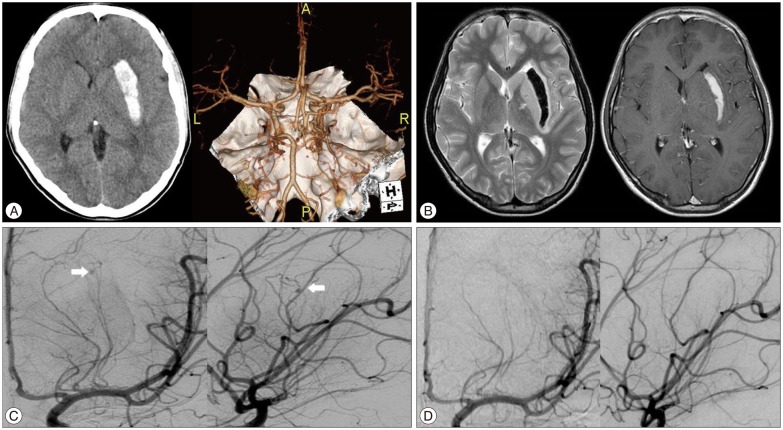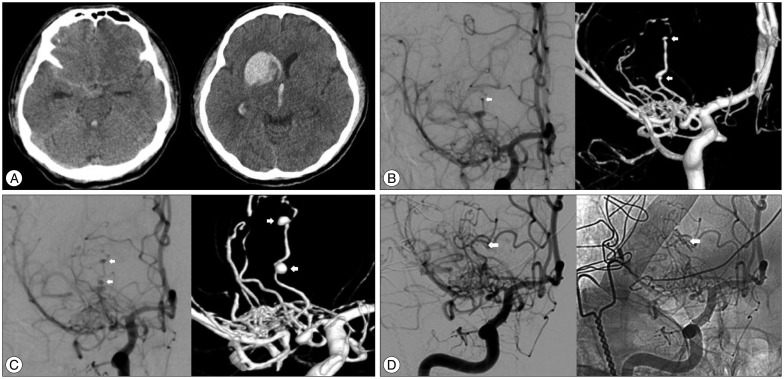J Korean Neurosurg Soc.
2015 Nov;58(5):471-475. 10.3340/jkns.2015.58.5.471.
Deep Intracerebral Hemorrhage Caused by Rupture of Distal Lenticulostriate Artery Aneurysm : A Report of Two Cases and a Literature Review
- Affiliations
-
- 1Department of Neurosurgery, Gangnam Severance Hospital, College of Medicine, Yonsei University, Seoul, Korea. JYJOO@yuhs.ac
- 2Department of Neurosurgery, Seoul St. Mary Hospital, College of Medicine, The Catholic University of Korea, Seoul, Korea.
- KMID: 2191414
- DOI: http://doi.org/10.3340/jkns.2015.58.5.471
Abstract
- Intracerebral hemorrhage (ICH) is common among various types of storkes; however, it is rare in young patients and patients who do not have any risk factors. In such cases, ICH is generally caused by vascular malformations, tumors, vasculitis, or drug abuse. Basal ganglia ICH is rarely related with distal lenticulostriate artery (LSA) aneurysm. Since the 1960s, a total of 29 distal LSA aneurysm cases causing ICH have been reported in the English literature. Despite of the small number of cases, various treatment methods have been attempted : surgical clipping, endovascular treatment, conservative treatment, superficial temporal artery-middle cerebral artery anastomosis, and gamma-knife radiosurgery. Here, we report two additional cases and review the literature. Thereupon, we discerned that young patients with deep ICH are in need of conventional cerebral angiography. Moreover, initial conservative treatment with follow-up cerebral angiography might be a good treatment option except for cases with a large amount of hematoma that necessitates emergency evacuation. If the LSA aneurysm still persists or enlarges on follow-up angiography, it should be treated surgically or endovascularly.
MeSH Terms
Figure
Reference
-
1. Ahn JY, Cho JH, Lee JW. Distal lenticulostriate artery aneurysm in deep intracerebral haemorrhage. J Neurol Neurosurg Psychiatry. 2007; 78:1401–1403. PMID: 18024696.
Article2. Albert FK, Wirtz CR, Forsting M, Jansen O, Polarz H, Mittermaier G, et al. Image guided excision of a ruptured feeding artery "pedicle aneurysm" associated with an arteriovenous malformation in a child : case report. Comput Aided Surg. 19973; 2:5–10. PMID: 9148874.
Article3. Bhat DI, Shukla DP, Somanna S. Subarachnoid hemorrhage from a ruptured proximal lenticulostriate artery aneurysm. Neurol India. 2012; 60:128–129. PMID: 22406808.
Article4. Binning M, Duhon B, Couldwell WT. Partially thrombosed lateral lenticulostriate aneurysm presenting with embolic stroke : case illustration. J Neurosurg Pediatr. 2010; 5:190. PMID: 20121369.
Article5. Cai X, Han S, Feske SK, Chou SH. Pearls and oy-sters : small but consequential : intracerebral hemorrhage caused by lenticulostriate artery aneurysm. Neurology. 2013; 80:e89–e91. PMID: 23439707.6. Chalouhi N, Tjoumakaris S, Gonzalez LF, Dumont AS, Shah Q, Gordon D, et al. Onyx embolization of a ruptured lenticulostriate artery aneurysm in a patient with moyamoya disease. World Neurosurg. 2013; 80:436.e7–436.e10. PMID: 22484074.
Article7. Eddleman CS, Surdell D, Pollock G, Batjer HH, Bendok BR. Ruptured proximal lenticulostriate artery fusiform aneurysm presenting with subarachnoid hemorrhage : case report. Neurosurgery. 2007; 60:E949. discussion E949. PMID: 17460507.8. Ellis JA, D'Amico R, Altschul D, Leung R, Connolly ES, Meyers PM. Medial lenticulostriate artery aneurysm presenting with isolated intraventricular hemorrhage. Surg Neurol Int. 2011; 2:92. PMID: 21748044.
Article9. Endo M, Ochiai C, Watanabe K, Yoshimoto Y, Wakai S. [Ruptured peripheral lenticulostriate artery aneurysm in a child : case report]. No Shinkei Geka. 1996; 24:961–964. PMID: 8914158.10. Gandhi CD, Gilad R, Patel AB, Haridas A, Bederson JB. Treatment of ruptured lenticulostriate artery aneurysms. J Neurosurg. 2008; 109:28–37. PMID: 18590430.
Article11. Grabel JC, Levine M, Hollis P, Ragland R. Moyamoya-like disease associated with a lenticulostriate region aneurysm. Case report. J Neurosurg. 1989; 70:802–803. PMID: 2709122.
Article12. Gupta AK, Rao VR, Mandalam KR, Kumar S, Joseph S, Unni M, et al. Thrombosis of multiple aneurysms of a lateral lenticulostriate artery. An angiographic follow-up. Neuroradiology. 1989; 31:193–195. PMID: 2747901.
Article13. Harreld JH, Zomorodi AR. Embolization of an unruptured distal lenticulostriate aneurysm associated with moyamoya disease. AJNR Am J Neuroradiol. 2011; 32:E42–E43. PMID: 20075103.
Article14. Hemphill JC 3rd, Bonovich DC, Besmertis L, Manley GT, Johnston SC. The ICH score : a simple, reliable grading scale for intracerebral hemorrhage. Stroke. 2001; 32:891–897. PMID: 11283388.15. Heran NS, Heran MS, Woolfenden AR. A corticosteroid-responsive aneurysmal lenticulostriate vasculopathy. Neurology. 2003; 61:1624–1625. PMID: 14663060.
Article16. Horn EM, Zabramski JM, Feiz-Erfan I, Lanzino G, McDougall CG. Distal lenticulostriate artery aneurysm rupture presenting as intraparenchymal hemorrhage : case report. Neurosurgery. 2004; 55:708. PMID: 16929579.17. Kalani MY, Martirosyan NL, Nakaji P, Spetzler RF. Microsurgical clipping of an unruptured lenticulostriate aneurysm. J Clin Neurosci. 2012; 19:1578–1580. PMID: 22925414.
Article18. Kaptain GJ, Sheehan JP, Kassell NF. Lenticulostriate artery aneurysm in infancy. Case illustration. J Neurosurg. 2001; 94:538. PMID: 11235964.19. Kidoguchi J, Chiba M, Murakami T, Saiki I, Kanaya H, Tazawa M, et al. [A case of systemic lupus erythematosus associated with an aneurysm of the lenticulostriate artery]. No Shinkei Geka. 1987; 15:1221–1225. PMID: 3325845.20. Kochar PS, Morrish WF, Hudon ME, Wong JH, Goyal M. Fusiform lenticulostriate artery aneurysm with subarachnoid hemorrhage : the role for superselective angiography in treatment planning. Interv Neuroradiol. 2010; 16:259–263. PMID: 20977857.
Article21. Kuroda S, Houkin K, Kamiyama H, Abe H. Effects of surgical revascularization on peripheral artery aneurysms in moyamoya disease : report of three cases. Neurosurgery. 2001; 49:463–467. discussion 467-468PMID: 11504126.
Article22. Lama S, Dolati P, Sutherland GR. Controversy in the management of lenticulostriate artery dissecting aneurysm : a case report and review of the literature. World Neurosurg. 2014; 81:441.e1–441.e7. PMID: 23246740.23. Lan Z, Li J, You C, Chen J. Successful use of Gamma Knife surgery in a distal lenticulostriate artery aneurysm intervention. Br J Neurosurg. 2012; 26:89–90. PMID: 21767129.
Article24. Larrazabal R, Pelz D, Findlay JM. Endovascular treatment of a lenticulostriate artery aneurysm with N-butyl cyanoacrylate. Can J Neurol Sci. 2001; 28:256–259. PMID: 11513346.
Article25. Lehmann P, Toussaint P, Depriester C, Legars D, Deramond H. [Lenticulostriate aneurysms. Radioclinical study]. J Neuroradiol. 2003; 30:115–120. PMID: 12717298.26. Maeda K, Fujimaki T, Morimoto T, Toyoda T. Cerebral aneurysms in the perforating artery manifesting intracerebral and subarachnoid haemorrhage--report of two cases. Acta Neurochir (Wien). 2001; 143:1153–1156. PMID: 11731866.27. Matushita H, Amorim RL, Paiva WS, Cardeal DD, Pinto FC. Idiopathic distal lenticulostriate artery aneurysm in a child. J Neurosurg. 2007; 107(5 Suppl):419–424. PMID: 18459908.
Article28. McCormick WF, Rosenfield DB. Massive brain hemorrhage : a review of 144 cases and an examination of their causes. Stroke. 1973; 4:946–954. PMID: 4765001.
Article29. Murakami H, Mine T, Nakamura T, Aki T, Suzuki K. [Intracerebral hemorrhage due to rupture of true aneurysms of the lenticulostriate artery in moyamoya disease. Case report]. Neurol Med Chir (Tokyo). 1984; 24:794–799. PMID: 6084185.
Article30. Narayan P, Workman MJ, Barrow DL. Surgical treatment of a lenticulostriate artery aneurysm. Case report. J Neurosurg. 2004; 100:340–342. PMID: 15086244.31. Ohta H, Ito Z, Nakajima K, Fukasawa H, Uemura K. [A case report of ruptured lenticulostriate artery aneurysm with arteriovenous malformation (author's transl)]. No To Shinkei. 1980; 32:839–846. PMID: 7470330.32. Oka K, Maehara F, Tomonaga M. Aneurysm of the lenticulostriate artery--report of four cases. Neurol Med Chir (Tokyo). 1991; 31:582–585. PMID: 1723172.33. Okuma A, Oshita H, Funakoshi T, Shikinami A, Yamada H. [A case of aneurysm in the cerebral myoyamoya vessel--aneurysmal rupture during cerebral angiography and spontaneous regression of the aneurysm (author's transl)]. No Shinkei Geka. 1980; 8:181–185. PMID: 7360320.34. Petrela M, Xhumari A, Azdurian E, Vreto G. [Aneurysm of the terminal part of the lenticulostriate artery]. Neurochirurgie. 1992; 38:50–52. PMID: 1560885.35. Sakai K, Mizumatsu S, Terasaka K, Sugatani H, Higashi T. Surgical treatment of a lenticulostriate artery aneurysm. Case report. Neurol Med Chir (Tokyo). 2005; 45:574–577. PMID: 16308516.36. Schürmann K, Brock M, Samii M. Circumscribed hematoma of the lateral ventricle following rupture of an intraventricular saccular arterial aneurysm. Case report. J Neurosurg. 1968; 29:195–198. PMID: 5673318.
Article37. Takeuchi S, Takasato Y, Masaoka H, Hayakawa T, Otani N, Yoshino Y, et al. Bilateral lenticulostriate artery aneurysms. Br J Neurosurg. 2009; 23:543–544. PMID: 19718551.
Article38. Tsai YH, Wang TC, Weng HH, Wong HF. Embolization of a ruptured lenticulostriate artery aneurysm. J Neuroradiol. 2011; 38:242–245. PMID: 21257203.
Article39. Vargas J, Walsh K, Turner R, Chaudry I, Turk A, Spiotta A. Lenticulostriate aneurysms : a case series and review of the literature. J Neurointerv Surg. 2015; 7:194–201. PMID: 24574545.40. Vates GE, Arthur KA, Ojemann SG, Williams F, Lawton MT. A neurocytoma and an associated lenticulostriate artery aneurysm presenting with intraventricular hemorrhage : case report. Neurosurgery. 2001; 49:721–725. PMID: 11523685.
Article
- Full Text Links
- Actions
-
Cited
- CITED
-
- Close
- Share
- Similar articles
-
- Endovascular Embolization of a Ruptured Distal Lenticulostriate Artery Aneurysm in Patients with Moyamoya Disease
- Distal Lenticulostriate Artery Aneurysm Presenting With Spontaneous Intracerebral and Intraventricular Hemorrhage: A Case Report and a Review of the Literature
- Ruptured Distal Lenticulostriate Artery Aneurysm Associated with Ipsilateral Middle Cerebral Artery Occlusion : Case Report
- Simultaneous Occurrence of Aneurysmal Subarachnoid Hemorrhage and Hypertensive Intracerebral Hemorrhage
- Subdural Hematoma Due to Ruptured Intracerebral Aneurysm



